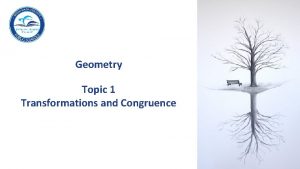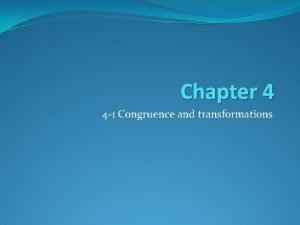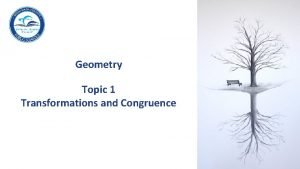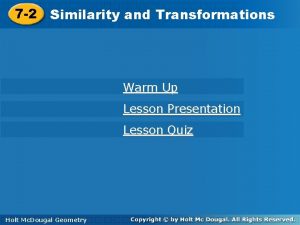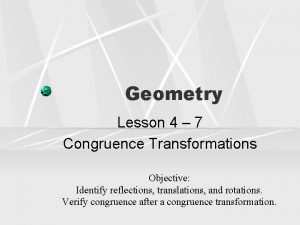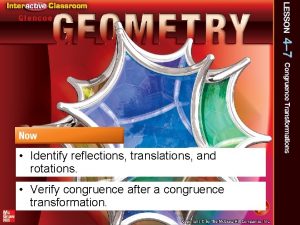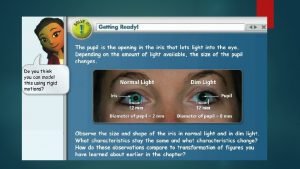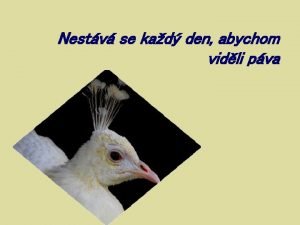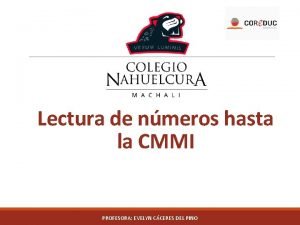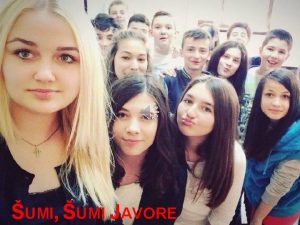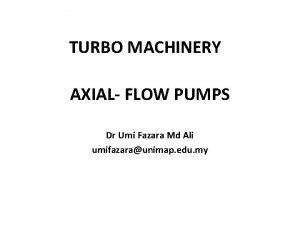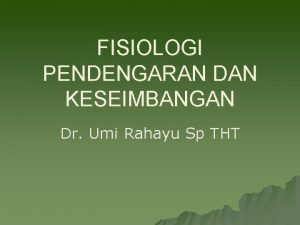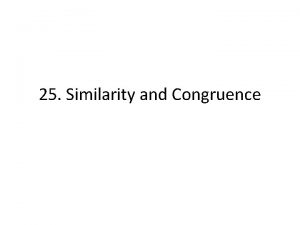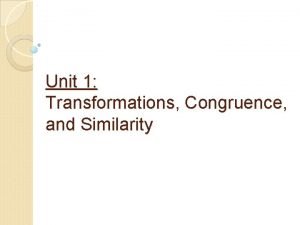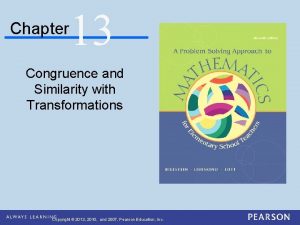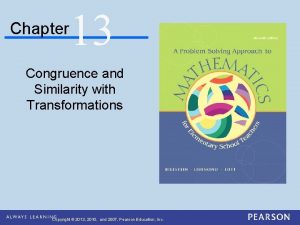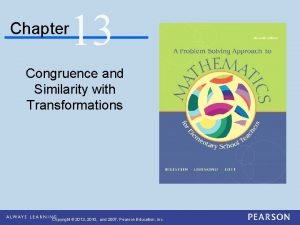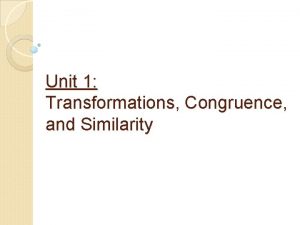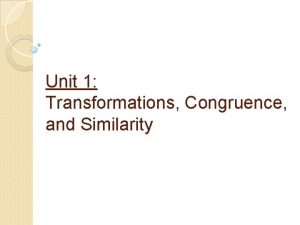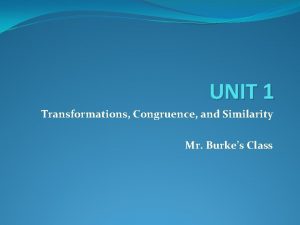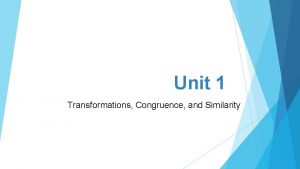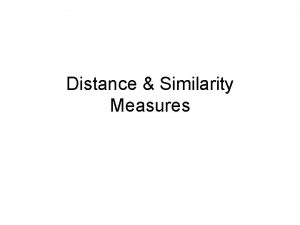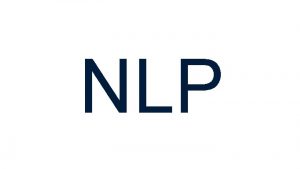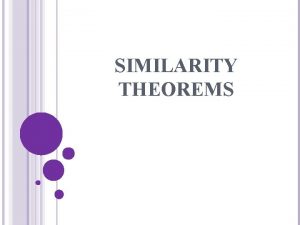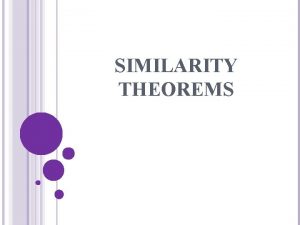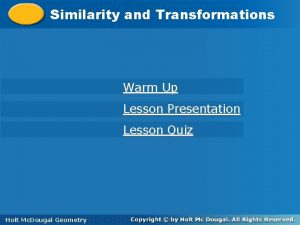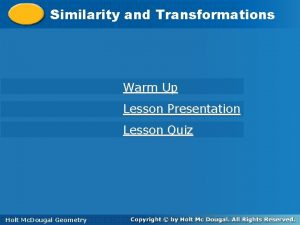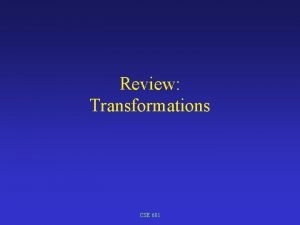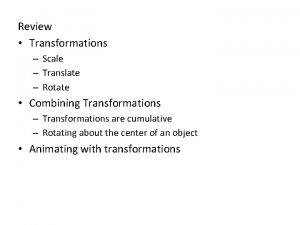Transformations Similarity and Congruence UMI July 19 2016






























- Slides: 30

Transformations Similarity and Congruence UMI: July 19, 2016

Transformation A transformation is a process which changes the position (and possibly the size and orientation) of a shape. There are four types of transformations: • • Rotation (Turn) Reflection (Flip) Translation (Slide) Enlargement (Resize)

Rotation (Turn) Rotation (also known as Turn) The distance from the center to any point on the shape stays the same. Every point makes a circle around the center. • Changes the orientation of the shape • Changes the position of the shape • Everything else stays the same.

Four Quadrants The x and y axes divide the space up into 4 pieces: Quadrants I, III and IV(They are numbered in a counterclockwise direction)

Example: Rectangle A′B′C′D′ is the image of rectangle ABCD after which of the following rotations? Find the new coordinate of the A′B′C′D′ A. A 90° clockwise rotation about the origin B. A 180° rotation about the origin C. A 90° counterclockwise rotation about the origin

Solution: C is correct. By joining A and A′ to the origin O, it is clear that this is a 90° counterclockwise rotation about the origin. The same distance from the origin. (Do the same for the other points and their images to see for yourself).

Practice 1: The square is rotated one complete turn about the point O. Which of the following shows the new position of the square?

Practice 2:

Practice 3: When this 'L'-shape is rotated about the origin (0, 0) by 90°counterclockwise, which one of these would it look like?

Reflection(Flip) Reflection (also known as Flip) in a line produces a mirror image in which corresponding points on the original shape and the mirror image are always the same distance from the mirror line. • Every point is the same distance from the central line ! • The reflection has the same size as the original image • The central line is called the Mirror Line

How Do It Myself? 1. Measure from 2. Measure the 3. Then connect same distance the point to the new dots up! again on the mirror line other side and (must hit the place a dot. mirror line at a right angle)

Practice 1: The square is flipped across the line L. Which of the following shows the new position of the square?

Practice 2: Rectangle A′B′C′D′ is the image of rectangle ABCD after reflection in which of the following lines? A. B. C. D. The x axis The y axis The line y = x The line y = -x

Practice 3: The rectangle is reflected in the line y = 4. Which one of the following shows the correct image?

Translation (Slide) Translation (also known as Slide) moves a shape by sliding it up, down, sideways or diagonally, without turning it or making it bigger or smaller. • Without rotating, resizing or anything else, just moving • Every point of the shape must move: Ø the same distance Ø in the same direction.

Example: Solution :

Practice 1: Write a rule to describe the translation: Solution :

Practice 2: The L-shape A′B′C′D′E′F′ is the image of the L-shape ABCDEF after which of the following translations? A. 5 units in the negative x direction and 8 units in the negative y direction B. 8 units in the negative x direction and 5 units in the negative y direction C. 8 units in the positive x direction and 5 units in the positive y direction D. 5 units in the positive x direction and 8 units in the positive y direction

Solution:

Practice 3: The 'L'-shape is translated 2 units in the positive x direction and 4 units in the positive y direction. Which one of the following shows the correct image? C correctly shows a translation of 2 units in the positive x direction and 4 units in the positive y direction.

Similar Two shapes are Similar when the only difference is size (and possibly the need to move, turn or flip one around). Similar figures • have equal corresponding angles • the length of their corresponding sides have equal ratios

Example: Determine whether the polygons are similar. Justify your answer Solution :

Example: Determine whether the polygons are similar. Justify your answer Solution :

Example: The triangles are similar. Find the value of x Solution :

Practice 1: The two trapezoids are similar. What is the value of x? Solution :

Practice 2: BC is parallel to DE. What is the length of BC? Solution :

Congruent If one shape can become another using Turns, Flips and/or Slides, then the shapes are Congruent figures • The same size • The same shape. • They are similar figures that are equal in size

Example: These figures are congruent. Find the measure of angle I. Solution :

Example: The two quadrilaterals are congruent. Which side in quadrilateral ABCD corresponds to WZ in quadrilateral WXYZ? Solution : 1. WZ faces the angles marked with two arcs and four arcs. 2. DA also faces the angles marked with two arcs and four arcs. 3. So DA corresponds to WZ.

Thank You References: 1. A problem solving approach to mathematics for elementary school teachers by Billstein, Libeskind, Lott 2. Math is Fun : https: //www. mathsisfun. com/ 3. Emathematics: http: //www. emathematics. net/
 Lesson 3 proving triangles similar
Lesson 3 proving triangles similar Geometry topic 1 transformations and congruence
Geometry topic 1 transformations and congruence Congruence and transformations
Congruence and transformations Geometry topic 1 transformations and congruence
Geometry topic 1 transformations and congruence 7-2 similarity transformations
7-2 similarity transformations The operation that maps or moves a preimage onto an image
The operation that maps or moves a preimage onto an image Identify the type of congruence transformation
Identify the type of congruence transformation A dilation is an enlargement if the scale factor
A dilation is an enlargement if the scale factor Prof umi narimawati
Prof umi narimawati Umi pav letat
Umi pav letat Cmi dmi umi cm dm um c d u
Cmi dmi umi cm dm um c d u Umi blata
Umi blata Planinski javor
Planinski javor Dr umi
Dr umi Dr umi rahayu sp tht
Dr umi rahayu sp tht Proquest umi
Proquest umi Umi dayati
Umi dayati March april may june
March april may june The harp mysteries of harris burdick
The harp mysteries of harris burdick Under the rug chris van allsburg
Under the rug chris van allsburg July 1-4 1863
July 1-4 1863 Tender mean
Tender mean Ruth bruno
Ruth bruno 2001 july 15
2001 july 15 2003 july 17
2003 july 17 July 30 2009 nasa
July 30 2009 nasa Sources nso frenchhowell neill mit technology...
Sources nso frenchhowell neill mit technology... May 1775
May 1775 Sylvia plath poppies in july
Sylvia plath poppies in july Hurrah for the fourth of july cartoon
Hurrah for the fourth of july cartoon Poppies in july poem
Poppies in july poem

